While the fashion industry has made clothing more accessible, with 80 billion more garments available every year and cheaper, people and the planet pay a steep price.
The “fast fashion” phenomenon has taken the world by storm, with retailers doubling their production and launching the fashion industry into becoming the 7th largest global economy.

If your clothes are mass-produced, cheap, poor quality, and disposable, it’s a fast-fashion item. Unfortunately, this has become a common trend despite horrible implications for our environment and society as a whole.
First, here’s a quick overview of the stats you’re about to read:
- Key Fast Fashion Statistics
- Fast Fashion Pollution
- Fast Fashion Waste
- Fast Fashion Water Consumption
- Fast Fashion Water Pollution
- Fast Fashion Carbon Emissions
- Fast Fashion Microplastic Pollution
- Fast Fashion Toxic Chemicals
- Fast Fashion Environmental Impact
- Fast Fashion Impact on Human Rights
- How to Help Stop Fast Fashion
Key Fast Fashion Statistics
In order to keep up with the runways and celebrities, fast fashion trends come as quickly as they go, which is why brands may put out a new collection every week.

Find that surprising?
Here are some other facts you might be shocked to learn.
- 1 in every 6 people work in the fashion industry
- More than $500 billion is lost because of underutilized clothes and a lack of recycling
- 30% of fast fashion items are unsold
- 1 in 3 young women consider clothes that are worn once or twice “old”
- Americans only wear 18% of their wardrobe
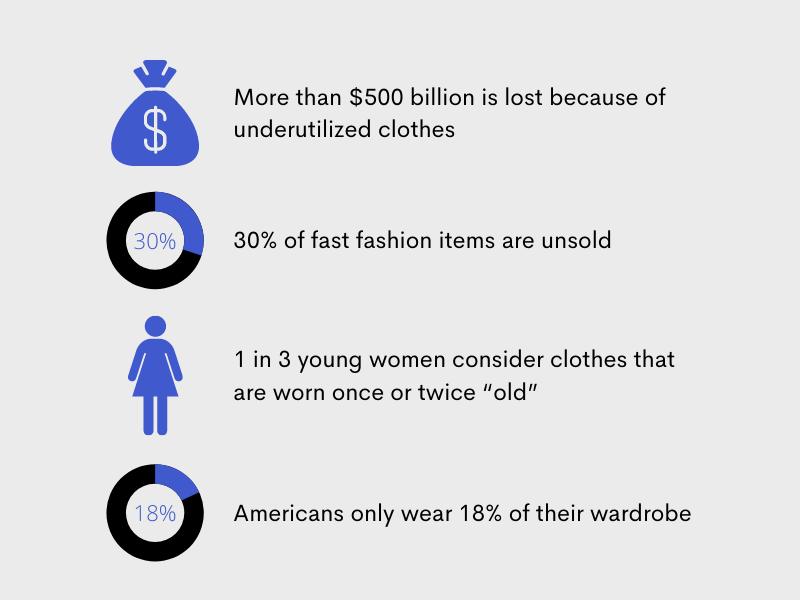
Sources: csc9000.org.cn, ellenmacarthurfoundation.org, sharecloth.com, businessoffashion.com, fashionunited.uk
Fast Fashion Pollution Statistics
By providing consumers with new items in short periods of time, it’s no surprise that the fashion industry:
- Contributes 8% to 10% of humanity’s carbon emissions, which is more than maritime shipping and international flights combined at 5%
- Is responsible for 1/3 of industrial water pollution due to manufacturing practices
- Is accountable for 20% to 35% of microplastic found in the ocean
- Uses 24% of insecticides and 10% to 20% of pesticides
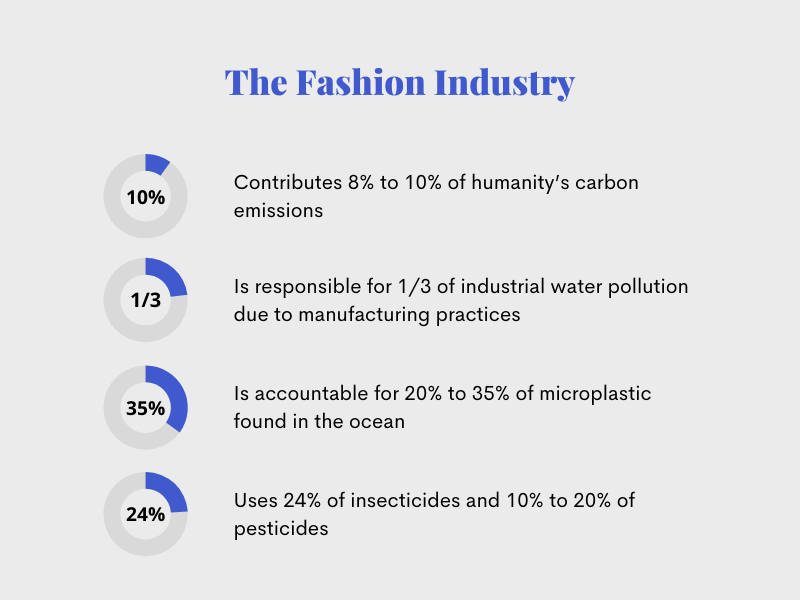
- Clothing consumption will rise by 63% by 2030, equivalent to 500 billion more shirts.
- Polyester is used in more than half (60%) of produced garments
- Polyester takes more than 200 years to decompose
- To make polyester fiber, 700 million barrels of oil are needed
To combat the negative effects of fast fashion, we have to understand what trendy clothes are doing to the environment. Only then can we take small steps that will make a big difference. Here’s what’s wrong with fast fashion and what we can do about it.
Sources: unep.org, mckinsey.com, parliament.uk, sagepub.com, forbes.com
Fast Fashion Waste Statistics
With fashion giants prioritizing low production costs, sustainability has never been a goal.
In fact, the industry consumes 98 million tons of non-renewable resources annually only to have a garbage truck of clothing and apparel dumped or burned in a landfill every second.
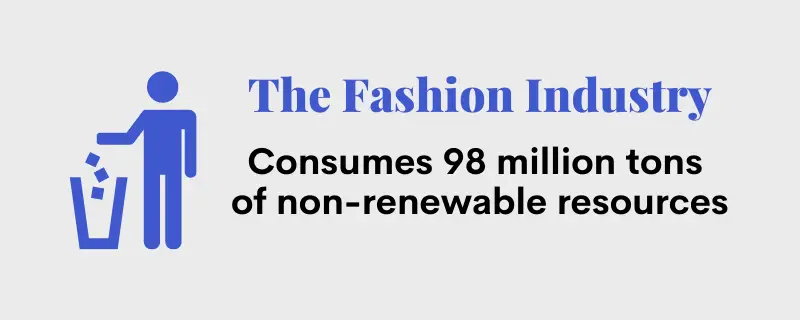
This amount of textiles can fill up Sydney Harbor twice a year.
Those that read this may think it’s a better idea than to burn these items instead. Unfortunately, that’s not a viable solution either.
Burning textiles that end up in landfills is one of the reasons that fast fashion is detrimental to the environment. The toxic substances and poisonous gases released due to incineration are also a health hazard to communities that live in and near landfills.
- The fashion industry consumes 98 million tons of non-renewable resources annually
- There is a garbage truck of clothing and apparel dumped or burned in a landfill every second.
- 92 million tons of garment and textile waste is discarded annually
- The average American will throw away 37 kgs (81 lbs) of clothing every year
- More than half of fast fashion clothing will be discarded within a year
- 3 out of 5 fast fashion items will wind up in a landfill
- Less than 1% of materials for clothing production is recycled

Sources: ellenmacarthurfoundation.org, weforum.org, globalfashionagenda.com, epa.gov, csc9000.org.cn, cleanclothes.org, parliament.uk
What Can You Do?
- Know the brands you shop from. Good on You app is a great site to check out how sustainable and transparent a brand is on the materials they use and their supply chain.
- Newer = Fewer. Make the most out of the clothes you have now by mending or altering them to repurpose them into something new. When you choose to shop, buy high-quality pieces that can be mixed and matched with your current wardrobe.
- Choose recycled. There are independent brands out there making new fashion pieces out of old ones. Fashion retailers also have programs that let you donate textiles if you’d like.
Fast Fashion Water Consumption Statistics
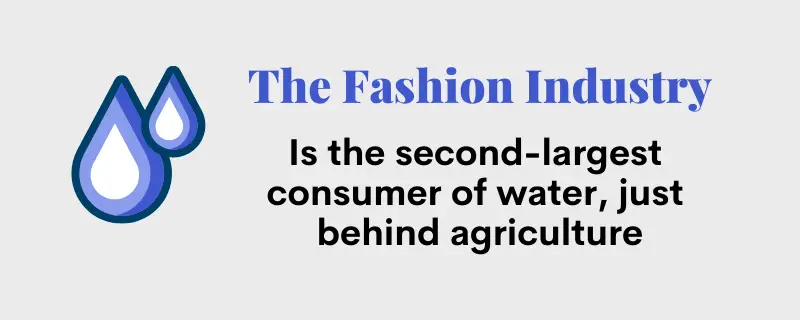
Overconsumption depletes our natural resources.
For example, did you know that it takes 713 gallons of water to produce a single white cotton t-shirt? Or that it takes 1981 gallons of water to grow the cotton needed for a pair of jeans?
Water-intensive clothing production is so rampant in some areas of the world that the Aral Sea in Uzbekistan, the 4th largest lake in the world, has dried up, and many are saying cotton production is one of the main factors to blame.
And it doesn’t seem like our society is changing its habits to help.
- The fashion industry is the second-largest consumer of water, just behind agriculture.
- It takes 713 gallons of water to produce a single white cotton t-shirt
- It takes 1981 gallons of water to grow the cotton needed for a pair of jeans
- The Aral Sea in Uzbekistan, the 4th largest lake in the world, has dried up, and many are saying cotton production is one of the main factors to blame.
Sources: worldwildlife.org, un.org, theguardian.com, unep.org
Fast Fashion Water Pollution Statistics
The fashion industry contributes to 20% of the industrial wastewater around the world. Bleaching, making garments water- or stain-resistant, anti-wrinkle, softer, or adding texture and the low-quality dyes require chemicals that end up being washed off into waterways.
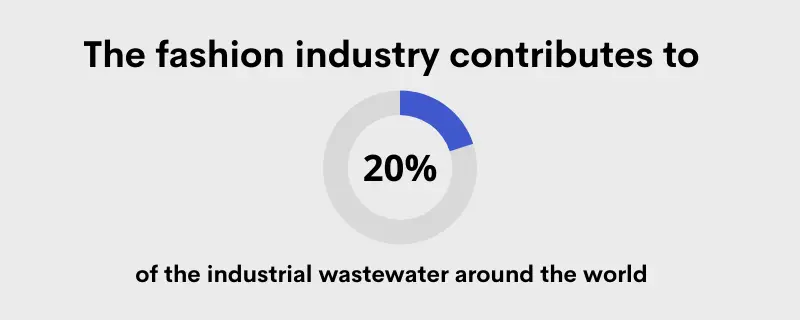
- The fashion industry contributes to 20% of the industrial wastewater around the world
- Textile dyeing is the 2nd largest water polluter
- 1 ton of dyed fabric needs 200 tons of water to be produced
- Textile mills use 20,000 chemicals to make clothes
- Only 1 in 10 fast fashion companies acknowledge that water pollution is an issue
- The chemicals and dyes used in garment finishes are detrimental to the environment. Unfortunately, more than 80% of wastewater is untreated but returned to the environment.
Sources: unep.org, unesco.org, nrdc.org. cpd.net
What Can You Do?
- Choose environmentally-friendly dyed fabric. Materials like organic cotton can be dyed with natural or organic dyes made out of turmeric, indigo, or cochineal.
- Buy from brands that treat their wastewater. Scandinavian nations are leading wastewater treatment, and developing countries are beginning to follow suit.
- Upcycle your clothing. Look for different ways to elevate your garments, like making them into another piece of clothing, adding some flair with paint, stitching, or embroidery.
Fast Fashion Carbon Emissions Statistics
It takes the same amount of CO2 emissions that driving your car for 56 km (or 35 miles) would to produce one cotton shirt, and the lifecycle of a pair of Levi’s jeans produces the same amount of greenhouse gas emissions as 111 km (59 miles) of driving does.
Every time you buy new clothes, the transportation, washing, and disposal process contributes to greenhouse gas emissions. If nothing changes, the fashion industry’s emissions are estimated to increase by 49% because consumption is projected to increase by 63% by 2030.
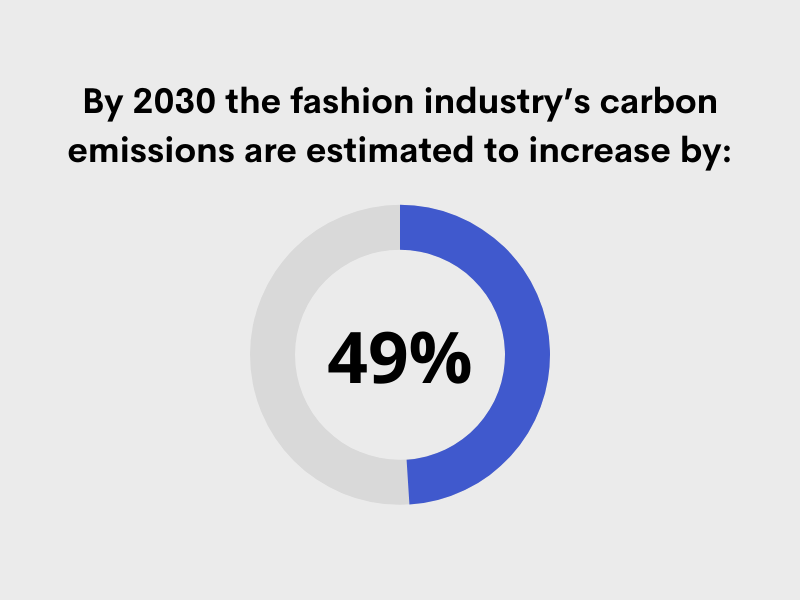
- It takes the same amount of CO2 emissions that driving your car for 56 km (or 35 miles) would to produce one cotton shirt
- The lifecycle of a pair of Levi’s jeans produces the same amount of greenhouse gas emissions as 111 km (59 miles) of driving does
- The fashion industry’s emissions are estimated to increase 49% by 2030
- Fashion industry consumption is projected to increase 63% by 2030
- The production of a polyester t-shirt produces 262% more emissions than a cotton shirt.
- Raw material production, preparation, and processing contribute to more than 70% of CO2 emissions.
- Only 17% of companies are transparent about their raw material carbon footprint.
- The textile industry is the 2nd most polluting industry.
Sources: Oxfam.com, levistrauss.com, quantis-intl.com, parliament.uk, globalcompostproject.org, mckinsey.com, fashionrevolution.org. greenmatch.co.uk
What Can you Do?
- Shop local. Clothes produced by small, local brands have a smaller carbon footprint than fast-fashion retailers.
- Support transparency. If you are going to purchase garments, support brands that are transparent about their supply chain and production practices.
- Try to buy natural fibers. Look for materials that do not put as much of a strain on the environment. Natural fibers to look out for include recycled cotton, organic hemp, and organic linen. More innovative fabrics that require less energy and water during production include Tencel, piñatex, Econyl, and Qmonos.
- Discard clothing with care. Donate, swap, or sell clothes you do not need anymore. ThredUp, Depop, The Real Real, and Poshmark are resale sites where you can post pictures of clothes and find a new home for them, or find new ones.
- Educate yourself. Learn about different ways to style your clothes so that you can wear them for years. Learn about how to maintain your clothes and repurpose garments in different ways.
Fast Fashion Microplastic Pollution
Fast fashion would not have been possible without polyester, which is readily available and cheap. Doing one load of laundry can potentially release 700,000 microfibers and wastewater treatment plants only capture about 40%. Microplastics wind up in the air, soil, and most bodies of water where they are consumed and harm marine life and those who consume them.
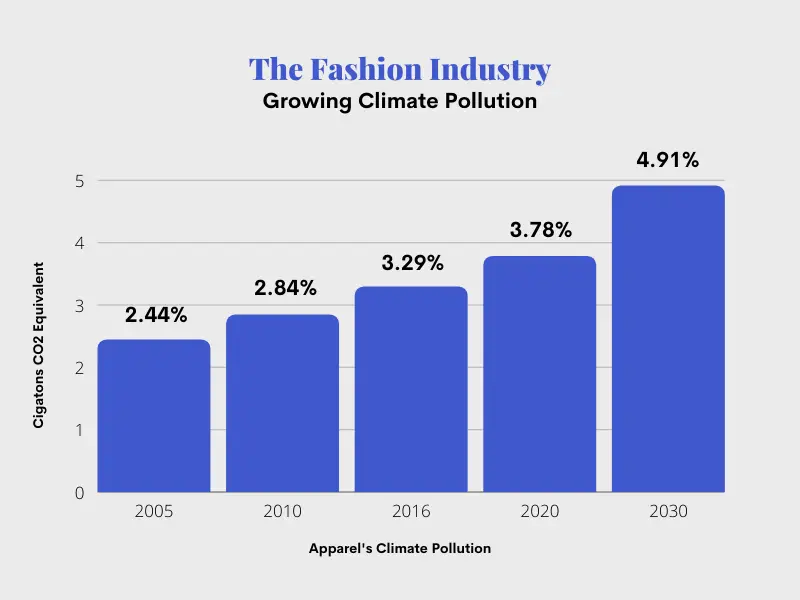
- 0.95 million tons of microplastics enter the environment every year
- 86% of drinking water contains microplastics
- Microfibers make up 35% of microplastic ocean waste
- We breathe in at least 13,000 to 68,000 microfibers a year
- In the US, 94% of water samples tested positive for microplastic pollution
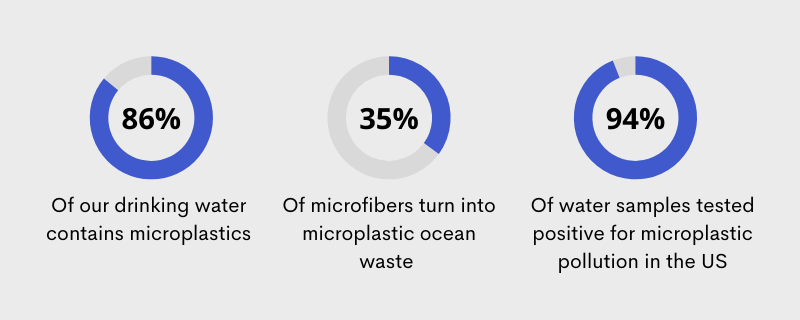
Source: Sciencedirect.com, eunomia.co.uk, orbmedia.org, researchportal.hw.ac.uk
What Can You Do?
- Wash clothes less often. Skip one in every six washing loads and opt for open-air drying instead.
- Choose tightly woven synthetic clothing. A study has found that when the yarn in a garment is twisted and compactly woven, there are fewer microfibers released when washing and in the air.
- Use lower temperatures. There are shorter washing cycles at low temperatures (usually 30°C ) or eco-cycles that give microplastics less time to be released.
Fast Fashion Toxic Chemicals
Fast fashion items are usually made out of synthetic materials that have been sprayed with chemicals or dyed that are toxic to both textile workers and consumers. The insecticides and pesticides that are used in textile manufacturing are detrimental to the workers who spray them and the land that cotton is grown on.
AZO dyes, which are used in 60% to 70% of all dyes, release chemicals when the fabric of a clothing piece comes in contact with skin. Per- and poly-fluorinated chemicals, or PFCs, are chemical additives used to make your clothing stain and waterproof can negatively affect your liver health. Heavy metals are used to dye and in leather tanning can damage your nervous system.

- AZO dyes, which are used in 60% to 70% of all dyes, release chemicals when the fabric of a clothing piece comes in contact with skin
- More than 8,000 chemicals are used when manufacturing raw material into clothing pieces
- 43 million tons of chemicals are needed to dye and treat clothes annually
- 90% of clothing in the US consists of toxic chemicals
- Only 35% of fast fashion brands take measures to ensure employees are not exposed to toxic chemicals
Sources: sciencedirect.com, greenamerica.org, biomedcentral.com, humanrights.org
What Can You Do?
- Choose organic fibers. Organic hemp, bamboo, ramie, or silk are materials that do not require fertilizer or pesticides.
- If you buy new, wash them first. This can help eliminate chemicals used to treat or dye your clothing that was not properly washed off.
- Invest in pieces with standards. Look for materials, fabrics, garments, and dyes that have been certified with the Global Organic Textile Standard (GOTS), EU Ecolabel, Bluesign®, or Oeko-Tex Standard 100. The GOTS certification ensures that textiles are manufactured sustainably from harvesting to manufacturing and labeling. The EU Ecolabel helps consumers identify healthier and more environmentally friendly products on the market. As for Bluesign, this certification signifies that products are tested for harmful substances and are deemed safe for humans and the environment. Similarly, the Oeko-Tex Standard 100 certification means that a garment has been tested against more than 100 harmful substances and is free from these health hazards.
Fast Fashion Environmental Impact
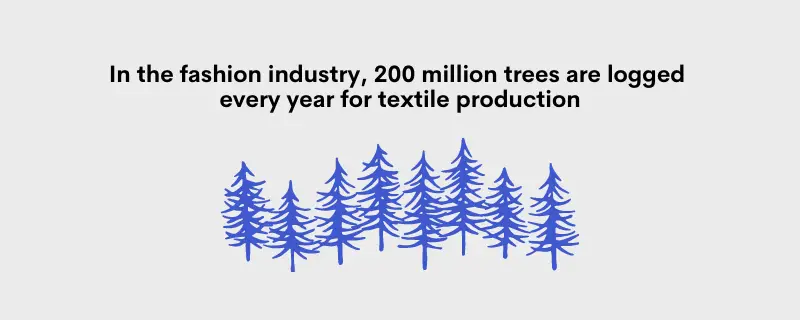
Half of the planet’s habitable land is used for “agriculture,” so it may be easy to forget that farming is not limited to food production but includes fashion.
The wood-based fibers used in fast fashion production contribute to wood depletion and endanger rainforest flora and fauna. These wood-based fibers include viscose, modal, rayon, and lyocell.
Soil degradation is another negative effect brought on by fast fashion. Overgrazing from farm animals is expected due to large amounts of sheep and goats being raised for garments made out of wool or cashmere. In addition, the chemicals used to grow cotton degrade the quality of the soil.
- 50% of the planet’s habitable land is used for “agriculture” and this includes materials for fashion products
- The fashion industry is expected to use 35% more land to produce fiber by 2030
- 2.4% of arable land is used for cotton
- 200 million trees are logged every year for textile production
Sources: Ourworldindata.org, unccd.int, worldwildlife.org, canopyplanet.org
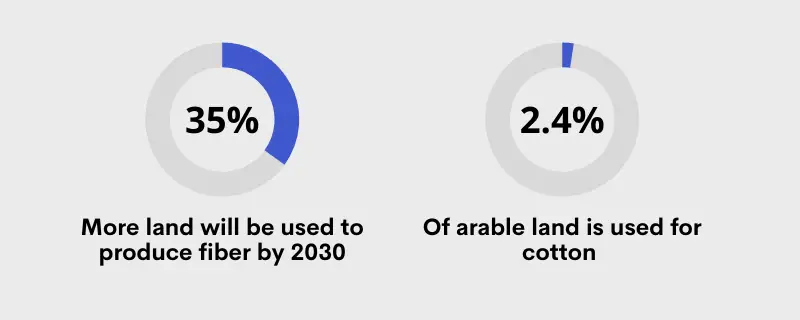
What Can You Do?
- Wear clothes for as long as you can. When you extend the life of a single piece of clothing by three months, you can significantly reduce your carbon footprint.
- Wear clothing that is made out of natural materials. This is the best way to ensure that they can naturally return to the earth.
- Invest in regenerative agriculture. The Kering Luxury Group, known for Gucci, Alexander McQueen, and Balenciaga, has recently co-founded a fund that will contribute and support regenerative farmers for more sustainable fields worldwide. Other brands showing their support for regenerative farmers include Patagonia, Eileen Fisher, The North Face, Stella McCartney, and Timberland.
Fast Fashion Impact on Human Rights
Fast fashion factories churn out clothes at an alarming rate, leading to inadequate labor conditions and wages that affect textile workers’ quality of life.

- Women represent 80% of garment workers worldwide
- The majority of apparel is made by women that are aged 18 years old to 24 years old
- 97% of fashion items are manufactured overseas
- Only 5 out of 250 big brands have published how they will work towards providing a living wage for their supply chain workers
- From 2016 to 2017, 2.8 million workers died due to work-related injuries and illness
- Garment workers only make about $96 every month when they need at least $336 for basic needs
- 93% of brands don’t pay their garment workers enough to make a living
- 160 million children around the world are forced to work
Sources: humanrights.org, remake.world, truecostmovie.com, issuu.com, cleanclothes.org, thefashionlaw.com, fashionchecker.org, ilo.org
Some big brands violate human rights with security shortcuts, no or late labor payments, extensive work hours, rejected maternity and sick leave, and physical abuse in order to meet production targets. With the need to make a living, garment workers would rather endure these conditions instead of quitting their jobs.
For example, in 2018 H&M was accused of failing to provide its supply chain workers with a living wage. In addition, Fast fashion giant Zara was charged with sourcing clothes from Brazilian factories that engage in modern slavery by forcing workers to work for 16 hours a day.
There has also been evidence of child and forced labor in the countries like Vietnam, Turkey, the Philippines, Indonesia, India, China, Brazil, Bangladesh, and Argentina. The fast fashion industry does not require highly-skilled workers, which is why child labor is so common in textile factories. The fashion supply chain is also infamous for forced labor, with governments forcing workers to leave their jobs and children to leave school in order to harvest cotton.
What Can You Do?
- Demand transparency. Support brands that keep track of what they are doing and how their products are manufactured.
- Support initiatives. You can share reports or sign petitions for investigations that offer textile workers fair working conditions and wages.
- Look for the Fairtrade label. Specifically for products from developing countries, this label is known for putting people before profit.
How to Help Stop Fast Fashion
Some of the best ways to do your part in tackling these fast fashion issues include:
- No longer buying from fast fashion brands. One of the quickest ways to stop contributing to the adverse effects of fast fashion is not buying from brands with unethical practices.
- Choosing to exchange clothes. Host a trade with your family, friends, or community. This is a simple way to switch up your wardrobe and find new homes for pieces you have outgrown.
- Rent, repair, or repurpose garments. Choose to rent clothes for events you are attending once instead of buying brand new clothing that may never see the light of day. You can also mend clothing that you constantly wear or choose to repurpose it into a fresh piece. Some brands offer mending services, and there are a lot of creatives out there that specialize in repurposing textiles and garments for more sustainable living.
- Choose second-hand as much as possible. Thrifting or choosing to shop at charity shops is a great way to upgrade your wardrobe without giving in to fast fashion. Many second-hand clothes are in good condition is a fraction of their original price. Check out your local Goodwill or shop on Poshmark or ThredUp.
- Wash your clothes only when necessary. Shirts and blouses can be worn more than once before needing to be washed, and jeans can be washed after being worn 10 times instead of 2. If you do choose to use a washing machine, use the eco setting, which will use less water, less electricity, and be gentler on your clothes.
- Support slow fashion brands. If you choose to buy new clothes, choose sustainable brands. So many slow fashion manufacturers offer stylish pieces that will last you a lifetime with proper care. Sustainable brands also make sure that the clothes they produce are environmentally-friendly and ethically made by giving garment workers what they deserve.
- Donate and support organizations or initiatives fighting against fast fashion. You can sign petitions, share articles, or donate to communities, charities, and non-profit organizations that are making a stand against the fast fashion industry. Greenpeace, Textile Exchange, and Fashion Revolution are a few you can check out.
Educate yourself and others. Take what you’ve learned here and do your own extensive research on how your clothes impact the environment and society. You can also share this article with your family and friends to get them thinking about how they can still be fashionable but in a more sustainable way.
